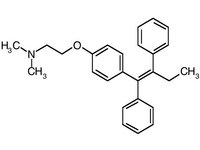Among women with hormone-receptor-positive breast cancer, the odds of recurrence or death are reduced by 47 and 26 percent, respectively, after five years of treatment with tamoxifen. The drug has beneficial systemic effects, such as protection against osteoporosis, but is associated with an increased risk of thromboembolism and a two to four times increased relative risk of endometrial carcinoma. New drugs, such as anastrozole, have been developed to combine the potency of tamoxifen with a decreased risk of adverse effects. A large international trial (the Arimidex [anastrozole], Tamoxifen, Alone or in Combination study) compared the effectiveness of anastrozole with tamoxifen and a combination of the drugs in 9,366 postmenopausal women with operable invasive breast cancer.
Patients were randomly assigned to one of three treatment groups after surgery and chemotherapy. The 3,125 women randomized to anastrozole were comparable to the 3,116 women assigned to tamoxifen and the 3,125 women assigned to combination therapy in terms of average age (64 years), body mass index (27 kg per [m.sup.2]), hysterectomy status (28 percent), and prior use of hormone-replacement therapy (35 percent). Patients were treated according to local practice policies. The women were assessed on entry to the study and at three months and six months, then every six months for five years, and annually thereafter. The median follow-up period was 33 months.
During the study, 231 women experienced local recurrence, 544 had distant recurrence, 75 developed cancer in the other breast, and 618 died. The disease-free survival was significantly longer in patients assigned to anastrozole only. At three years, the disease-free survival rates were 89.4 percent in the anastrozole group, 87.4 percent in the tamoxifen group, and 87.2 percent in the combination group. The disease-free survival rates at three years for hormone-receptor-positive women were 91.2 percent in the anastrozole group, 89.3 percent in the tamoxifen group, and 88.9 percent in the combination group. Anastrozole also was associated with a significantly longer time to recurrence in receptor-positive women. The odds of a second primary cancer in the contralateral breast were reduced by 58 percent in women treated with anastrozole compared with women treated with tamoxifen. This reduction is clinically significant; 83 percent of these second primary cancers were invasive.
Overall, the three treatments had a similar number of adverse effects, but significantly fewer withdrawals occurred with anastrozole. The pattern of adverse effects differed depending on the drug. Anastrozole was significantly less likely to be associated with hot flashes, vaginal discharge or bleeding, thromboembolic events, and endometrial cancer. Conversely, anastrozole was significantly more likely to be associated with musculoskeletal disorders--principally arthralgia--and fractures of the spine.
The authors conclude that anastrozole therapy is superior to tamoxifen or the combination therapy in patients with hormone-receptor-positive disease. The effect was most powerful in preventing or delaying new primary cancers in the contralateral breast. The role of this new class of agents will be determined after further studies of effectiveness and clarification of side effects; nevertheless, postmenopausal women with hormone-responsive tumors now have a choice of effective agents with different characteristics.
COPYRIGHT 2002 American Academy of Family Physicians
COPYRIGHT 2002 Gale Group



